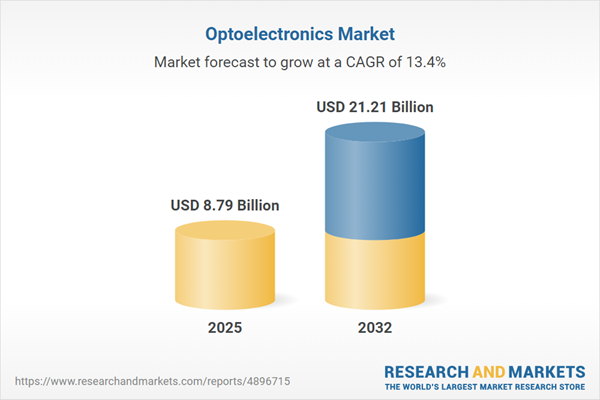Speak directly to the analyst to clarify any post sales queries you may have.
The optoelectronics market is in transition, driven by advancements in materials, device design, and regulatory change. Senior decision-makers require reliable insights to anticipate emerging challenges, seize new opportunities, and integrate agile strategies in a rapidly shifting landscape.
Market Snapshot: Optoelectronics Market Size and Trends
The optoelectronics market is advancing, supported by a robust compound annual growth rate and rising overall global value. Increased demand for advanced imaging, lighting, and sensing technologies across multiple sectors—including consumer electronics, healthcare, automotive, energy, and telecommunications—is spurring this steady growth. These technologies are now integral to improving workflows and creating new service offerings, accelerating innovation cycles. As regulatory frameworks and optoelectronic technologies continue to evolve, industry executives adjust strategies to ensure portfolio competitiveness and maintain alignment with market developments.
Scope & Segmentation of the Optoelectronics Market
This report delivers a comprehensive view of the optoelectronics market structure, equipping leaders with segmentation insights to identify expansion and risk mitigation opportunities in complex environments. The following core areas are analyzed:
- Product Types: Displays, CCD and CMOS image sensors, infrared components, laser diodes, LEDs, OLEDs, optical fibers, optocouplers, photodetectors, solar cells, and photovoltaic modules. These enable connected devices, support intelligent lighting, automate industrial systems, and enhance communications performance.
- Material Types: Gallium arsenide, gallium nitride, germanium, indium gallium arsenide, indium phosphide, silicon, and zinc selenide. Material choices influence energy efficiency, durability, and the feasibility of cutting-edge applications for both mature and emerging segments.
- Application Areas: Aerospace, defense, automotive, mobile devices, consumer electronics, energy, healthcare, automated manufacturing, security and surveillance, technical lighting, and telecommunications. Each sector presents unique avenues for leveraging optoelectronics to meet shifting technological and market demands.
- Regional Coverage: Americas, Europe, Middle East and Africa, Asia-Pacific, with a specific focus on key markets such as China, Germany, India, Japan, Brazil, and the UK. Regional dynamics shape regulatory approaches, supply chain logistics, and commercial opportunities—requiring tailored market entry strategies.
- Key Companies: Broadcom Inc., ams OSRAM AG, Samsung Electronics Co., Ltd., Lumentum Holdings Inc., II-VI Incorporated, Hamamatsu Photonics K.K., Sony Group Corporation, Nichia Corporation, Sharp Corporation, Wolfspeed, Inc. These industry leaders shape technology standards, nurture research partnerships, and set benchmarks for supply chain practices.
Optoelectronics Market: Key Takeaways for Decision-Makers
- Adopting modular platforms enhances the agility to adjust operations or scale product portfolios as business requirements shift or customer needs evolve.
- Integrating AI with sensing solutions enables improved precision in critical processes, driving gains across automotive, manufacturing, and industrial deployments.
- Focusing on sustainable design and developing energy-efficient optoelectronic devices supports regulatory compliance and advances corporate sustainability goals.
- Pursuing targeted mergers and partnerships builds resilience, supports sharing of specialist knowledge, and maintains continuity during regulatory or technology transitions.
- Implementing digital twins and predictive analytics improves manufacturing by optimizing asset use, boosting operational efficiency, and minimizing production risk.
- Investing in advanced compound semiconductor materials, such as gallium nitride and indium phosphide, unlocks high-performance device capabilities and drives next-generation production innovation.
Tariff Impact: Navigating Regulatory Shifts
Recent US tariff changes have prompted organizations to rethink sourcing and operational models. Many are now diversifying suppliers, growing regional manufacturing footprints, and developing local partnerships to safeguard supply chains and reduce regulatory risk exposure.
Methodology & Data Sources
The report’s analysis is based on comprehensive secondary research, interviews with industry executives, and direct insights from supply chain stakeholders. Findings are validated through industry surveys and peer-reviewed assessments, ensuring relevance to strategic decision-making in the optoelectronics market.
Why This Report Matters
- Offers clear, actionable insights to inform growth plans, risk management, and market entry or expansion decisions.
- Supports benchmarking against technology trends and regulatory developments, helping leaders execute responsive strategies in a complex, global environment.
- Guides change management, investment prioritization, and compliance strategy with intelligence tailored to evolving industry conditions.
Conclusion
This report provides senior executives with critical intelligence and strategic direction to capitalize on new opportunities, foster innovation, and guide growth as the optoelectronics sector progresses.
Additional Product Information:
- Purchase of this report includes 1 year online access with quarterly updates.
- This report can be updated on request. Please contact our Customer Experience team using the Ask a Question widget on our website.
Table of Contents
3. Executive Summary
4. Market Overview
7. Cumulative Impact of Artificial Intelligence 2025
Companies Mentioned
The companies profiled in this Optoelectronics market report include:- Broadcom Inc.
- ams OSRAM AG
- Samsung Electronics Co., Ltd.
- Lumentum Holdings Inc.
- II-VI Incorporated
- Hamamatsu Photonics K.K.
- Sony Group Corporation
- Nichia Corporation
- Sharp Corporation
- Wolfspeed, Inc.
Table Information
| Report Attribute | Details |
|---|---|
| No. of Pages | 190 |
| Published | November 2025 |
| Forecast Period | 2025 - 2032 |
| Estimated Market Value ( USD | $ 8.79 Billion |
| Forecasted Market Value ( USD | $ 21.21 Billion |
| Compound Annual Growth Rate | 13.3% |
| Regions Covered | Global |
| No. of Companies Mentioned | 11 |









